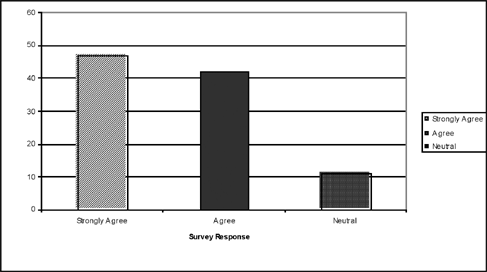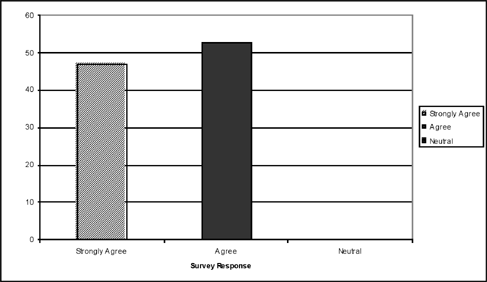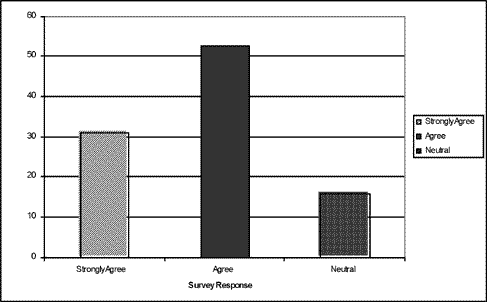October 2005 // Volume 43 // Number 5 // Feature Articles // 5FEA6
A Model for Recruiting and Training Youth Development Volunteers in Urban Areas
Abstract
A model for recruiting and training volunteers
for 4-H Youth Development Programs in urban areas was designed and evaluated.
Utilizing a formal course at a community college to recruit and train volunteers,
the model was effective in developing and enhancing their skills. As part
of their course requirements, volunteers applied their skills by implementing
a science literacy program with elementary-age children in after-school settings.
Their efforts were effective; participating children's science process skills
showed significant improvements. Academic and community service credit served
as rewards for volunteers' participation.
Introduction
Extension educators from the University of California designed and implemented a unique method of recruiting and training volunteers for Youth Development Programs in urban areas. The Community Science Education and Leadership (SEAL) Project utilized a formal college course to recruit and train teen and adult volunteer leaders to implement a science literacy program with elementary-age children in after-school settings. To accomplish the recruitment, training, and implementation phases of the Community SEAL Project, a close association among partner institutions and organizations was required.
Background
The balance of 4-H membership has shifted since the program's inception over 100 years ago, when 4-H served primarily rural youth (Enfield, 2001). Currently, 8% of the 4-H members nationally reside in the suburbs, and 25% live in the metropolitan areas of cities over 50,000 (USDA, 2003). With this change in membership demographics comes a need to recruit and train new volunteers to lead Youth Development Programs in urban areas.
Extension Youth Development Programs are built upon a foundation of volunteer leaders. In 2003, 562,923 volunteers from across the nation worked directly with 4-H youth (USDA, 2003). Traditionally, the recruitment of volunteers is accomplished by contacting individuals who have direct connections to Youth Development Programs. These volunteers typically have children involved in 4-H, and the length of time they commit corresponds with the length of time their children are engaged in a project or activity (Fritz, Karmazin, Barbuto, & Burrow, 2003). However, Fritz et al. (2003) describe these 4-H volunteer recruitment strategies as "timeworn and possibly a mismatch for the urban population."
In order to expand the pool of volunteers, recruitment strategies must be broadened and diversified to reflect the current youth population (Ewert & Rice, 1994). To accomplish this goal, recruitment must extend beyond those individuals with family ties to the program (White & Arnold, 2003). Furthermore, to operate successful Youth Development Programs, it is essential to train volunteers effectively (Smith, et al., 2004).
Effective training improves volunteers' skills and abilities, thus enhancing the programs they lead (Hoover & Connor, 2001). Furthermore, training increases the potential for sustaining programs over time (Snider, 1985) and improves the rate of volunteer retention (Van Winkle, Busler, Bowman, & Manoogian, 2002). Strategies for improved recruitment and training of volunteer leaders are especially pertinent in urban areas because program delivery methods and techniques vary widely due to the diversity of the audiences served (Fehlis, 1992). In the current study, an innovative approach to recruiting and training volunteer leaders in an urban area was applied and evaluated.
Methods
The Community SEAL Project involved teen and adult Extension volunteers enrolled in a course offered through Grossmont College. Part of the California Community College system, Grossmont College provides a diverse 2-year program to students in the El Cajon/San Diego metropolitan area. The Community SEAL Project was offered twice, once in each of two academic years. In year one, 10 adult volunteers participated; in year two, 15 volunteers (seven adults; eight teens) enrolled.
The teen and adult volunteers were recruited through the Grossmont College's Community Service Learning Program, general campus announcements, and associations with Service Learning and Career Education Departments at area high schools. The volunteer leaders who participated in the Community SEAL Project were from diverse ethnic and cultural backgrounds representative of metropolitan San Diego, including African American, Anglo, Chinese, Korean, Iraqi, Latino, Phillipino, and Vietnamese. Additionally, although some individuals had experience volunteering in other capacities (e.g., church youth programs, community arts and culture programs), only one participant had prior experience as a 4-H leader.
Participants received three units of undergraduate credit for a one-semester (16 weeks) elective course Community Science Education and Leadership. The course was developed and taught by academic staff from the University of California, Davis, Veterinary Medicine Extension, and the University of California Cooperative Extension, San Diego County, 4-H Youth Development Program.
Course content included weekly seminars on topics related to effective science outreach with youth audiences, including: inquiry-based science methods, questioning strategies, age-appropriate teaching methods, curriculum content and implementation strategies, team building, evaluation, and education to diverse audiences. Additional topics included community college-to-university transfer procedures and career exploration. Among the guest seminar speakers were other Extension educators, academic personnel from the University of California and California State University, and individuals from local and regional community organizations (e.g., San Diego City Schools, San Diego Zoo Education Department).
In addition to the course seminars, there were weekly "community laboratories" that served as authentic applications of educational theories and curriculum methods. Participating teens and adults worked in teams of four or five individuals to implement a hands-on, inquiry-based science curriculum with upper elementary age children enrolled in after school programs co-operated by the San Diego County 4-H Education Foundation, the Cajon Valley Elementary School, and El Cajon Park and Recreation District. This applied element of the Community SEAL Project focused on the children's understanding of curriculum content and their acquisition and use of science process skills.
Results
The Community SEAL Project's organizational approach combined educational theory and authentic experience to address specific project goals. One major goal was to contribute to the development and/or enhancement of skills important to the success of volunteers in Youth Development Programs. A post-project survey was administered to participating teens and adults in order to evaluate the impact of the Community SEAL Project on this construct. Using a Likert scale, responses were rated as: SA = strongly agree; A = agree; N = neutral; D = disagree; SD = strongly disagree; or NA = not applicable. Additionally, data from a post-project focus group interview with the participants were used to triangulate the survey results. The data presented represent the combined results from both years the Community SEAL Project was offered.
Post-Project Survey
Outcome data from post-project surveys (N = 19) revealed that the Community SEAL Project helped the teen and adult volunteers strengthen important career and life skills, including leadership, teamwork, communication, organization, and problem-solving (Figures 1 – 5). Results also showed that 89% (63% Strongly Agree; 26% Agree) of the participants surveyed indicated that they will volunteer their time again in the future.
Figure 1.
Volunteers' Responses to Post-Project Survey: Through My Participation
in Community SEAL, I Have Improved My Leadership Skills.

Figure 2.
Volunteers' Responses to Post-Project Survey: Through My Participation
in Community SEAL, I Have Improved My Teamwork Skills.

Figure 3.
Volunteers' Responses to Post-Project Survey: Through My Participation
in Community SEAL, I Have Improved My Communication Skills.

Figure 4.
Volunteers' Responses to Post-Project Survey: Through My Participation
in Community SEAL, I Have Improved My Organizational Skills.

Figure 5.
Volunteers' Responses to Post-Project Survey: Through My Participation
in Community SEAL, I Have Improved My Problem-Solving Skills.

Post-Project Focus Group Interviews
Focus group interviews provided evidence that the Community SEAL Project was successful in recruiting and training new volunteer leaders for a Youth Development Program in an urban area. Participants revealed that they would not have become involved with youth in their community had it not been for this project. The teens and adults also reported that the training seminars prepared them for facilitating inquiry-based activities with the children at the after-school sites. They stated that their participation in the Community SEAL Project changed the way they viewed teaching and science education, and many volunteers expressed that their participation in Community SEAL had sparked their interest in pursuing a career in education.
Focus group interview data also supported survey outcomes and provided additional insights into impacts on participating volunteers. Data revealed that participation in the Community SEAL Project had influenced the volunteers' own learning styles. They stated that they were applying the project's inquiry approach and its associated problem-solving skills to situations they encountered in their own lives.
Furthermore, through their involvement in the "community laboratories," volunteers reported that they had discovered they could work with children in a nurturing manner that they did not think they were capable of prior to their participation in the project. The volunteers revealed that the children communicated openly with them and that their positions as cross-age teachers took on mentorship qualities. The teens and adults believed that their roles as cross-age teachers benefited the children in a broader context, viewing themselves as positive role models for the children to emulate. They recognized and reported reciprocal positive relationships that developed and endured throughout the project.
Impact on Targeted Youth Audience
Effective training makes volunteers better educators (Hoover & Conner, 2001). Although youth audiences are not involved directly in the training of volunteers, through their improved learning they are the beneficiaries of training activities and thus represent the overarching goal of these efforts (Loucks-Horsley, Hewson, Love, & Stiles, 1998).
The teen and adult volunteers who participated in the Community SEAL Project were effective in implementing a hands-on, inquiry-based science curriculum with upper elementary age children enrolled in urban after school programs. An additional project goal was to improve the science literacy of participating children by increasing their use of the Scientific Thinking Processes (Lowery, 1992). Changes in the target audience's use of the process skills observation, measurement, communication, classification, prediction, and inference were measured using the Test of Basic Process Skills (BAPS) (Padilla, 1991), a multiple-choice test that has been validated and reliability-tested with elementary-age children. Data from 28 pre-/post- matched sets (16 girls; 12 boys) of upper-elementary age children (mean age = 10) were analyzed. Significant improvement (ANOVA testing; pre-test M = 12.29; post-test M = 14.54; F [1,54] = 11.79, p = .001) was found in BAPS scores for all children from pre-test to post-test administrations.
Discussion
With the shift in national 4-H membership to where one in four youth lives in metropolitan areas (USDA, 2003), Youth Development Programs need to expand their pool of volunteers through innovative recruitment and training strategies. The Community SEAL Project provides a unique model for recruiting and training teen and adult volunteers in urban areas. Individuals were recruited for this project through community partners, which served to diversify the age, ethnicity, background, and experience of the participants enrolled. Furthermore, by sharing responsibilities in working toward a common goal, this recruitment approach enhanced communication and helped strengthen ties between Extension and community collaborators.
For participating teen and adult volunteers, the Community SEAL Project provided weekly trainings that paralleled concurrent Youth Development Program applications, as well as recurring opportunities for peer reflection and mentoring by trainers. Previous studies have demonstrated that this incremental training approach serves to strengthen volunteer leader capacity over time (Smith & Enfield, 2002). Accordingly, volunteers enhanced career and life skills as a result of their participation.
It is important to reward volunteers for their service to the Youth Development Program. Rewards serve as key motivators for volunteer participation and retention (Hiller, 1998; Rouse & Clawson, 1992). In the Community SEAL Project, teen and adult volunteers earned formal academic credit through Grossmont College; teen participants also received service learning credit from their high schools.
Conclusion
It is critical for Extension to recruit and train new volunteers to extend Youth Development Programs to urban populations. The volunteer base needs to be broadened and diversified in order to reflect the demographics of current 4-H members and to reach new youth audiences. The Community SEAL Project was effective in developing and enhancing the skills of participating volunteers, and, in turn, the volunteers were effective in having a positive impact on their target audience. Project administrators believe this approach could serve as a model for the recruitment and training of Extension volunteers for other urban-based Youth Development Programs.
Acknowledgements
The authors would like to thank Cheryl L. Meehan, Post Graduate Researcher, Veterinary Medicine Extension, School of Veterinary Medicine, University of California, Davis, California, and Richard P. Enfield, 4-H Youth Development Advisor, University of California Cooperative Extension, San Luis Obispo County, California.
References
Enfield, R. P. (2001). Connections between 4-H and John Dewey's Philosophy of Education. FOCUS. Davis: 4-H Center for Youth Development, University of California, Winter.
Ewert, M. D., & Rice, J. A. K. (1994). Managing diversity within Cooperative Extension. Journal of Extension [On-line], 32(2). Available at: http://www.joe.org/joe/1994august/a1.html
Fehlis, C. P. (1992). Urban Extension programs. Journal of Extension [On-line], 30(2). Available at: http://www.joe.org/joe/1992summer/a3.html
Fritz, S., Karmazin, D., Barbuto, J., & Burrow, S. (2003). Urban and rural 4-H adult volunteer leaders' preferred forms of recognition and motivation. Journal of Extension [On-line], 41(3). Available at: http://www.joe.org/joe/2003june/rb1.shtml
Hiller, J. (1998). Recognizing volunteers: Right from the start. Journal of Extension [On-line], 36(1). Available at: http://www.joe.org/joe/1998february/ttl.html
Hoover, T., & Connor, N. J. (2001). Preferred learning styles of Florida association for famiy and community education volunteers: implications for professional development. Journal of Extension [On-line], 39(3). Available at: http://www.joe.org/joe/2001june/a3.html
Loucks-Horsley, S., Hewson, P., Love, N., & Stiles, K. (1998). Designing professional development for teachers of science and mathematics. Thousand Oaks, CA, USA: Corwin Press.
Lowery, Lawrence F. (1992). The Scientific Thinking Processes. Full Option Science System (FOSS), Lawrence Hall of Science, University of California, Berkeley.
Padilla, M. J. (1991). S. Glynn, R. Yeany, & B. Britton. (Eds.). The psychology of learning science [Science activities, process skills, and thinking]. Hillsdale, New Jersey, USA: Lawrence Erlbaum Associates.
Rouse, S. & Clawson, B. (1992). Motives and incentives of older adult volunteers. Journal of Extension [On-line], 40(6). Available at: http://www.joe.org/joe/1992fall/a1.html
Smith, M. H., & Enfield, R. P. (2002). Training 4-H teen facilitators in inquiry-based science methods: The evaluation of a "step-up" incremental training model. Journal of Extension [On-line], 40(6). Available at: http://www.joe.org/joe/2002december/a3.shtml
Smith, M. H., Meehan, C. L., Enfield, R. P., George, J. L., & Young, J. C. (2004). Improving county-based science programs: Bringing out the science teacher in your volunteer leaders. Journal of Extension [On-line], 42(6). Available at: http://www.joe.org/joe/2004december/a5.shtml
Snider, A. (1985). The dynamic tension: professionals and volunteers. Journal of Extension [On-line], 23(3). Available at: http://www.joe.org/joe/1985fall/sa2.html
United States Department of Agriculture (USDA). (2003). Annual 4-H Youth Development Enrollment Report. Retrieved March 8, 2005 from http://www.national4-hheadquarters.gov/2003-es237.pdf
Van Winkle, R., Busler, S., Bowman, S., & Manoogian, M. (2002). Adult volunteer development: Addressing the effectiveness of training new 4-H leaders. Journal of Extension [On-line], 40(6). Available at: http://www.joe.org/joe/2002december/a4.shtml
White, D. & Arnold, M. (2003). Why they come, why they go, and why they stay: Factors affecting volunteerism in 4-H programs. Journal of Extension [On-line], 41(4). Available at: http://www.joe.org/joe/2003august/rb5.shtml
